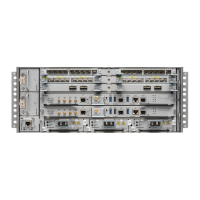Never defeat the ground conductor or operate the equipment in the absence of a suitably installed ground
conductor. Contact the appropriate electrical inspection authority or an electrician if you are uncertain that
suitable grounding is available. Statement 213.
Warning
The plug-socket combination must be accessible at all times because it serves as the main disconnecting
device. Statement 1019.
Warning
This product requires short-circuit (overcurrent) protection, to be provided as part of the building installation.
Install only in accordance with national and local wiring regulations. Statement 1045.
Warning
Guidelines for DC-Powered Systems
Basic guidelines for DC-powered systems include the following:
• Each chassis power supply should have its own dedicated input power source. The source must comply
with the safety extra-low voltage (SELV) requirements in the UL 60950, CSA 60950, EN 60950, and
IEC 60950 standards.
• The circuit must be protected by a dedicated two-pole circuit breaker. The circuit breaker should be sized
according to the power supply input rating and local or national code requirements.
• The circuit breaker is considered the disconnect device and should be easily accessible.
• The system ground is the power supply and chassis ground.
• Do not connect the DC return wire to the system frame or to the system-grounding equipment.
• Use the grounding lug to attach a wrist strap for ESD protection during servicing.
Preventing Power Loss
Use the following guidelines to prevent power loss to the router:
• To prevent loss of input power, ensure that the total maximum load on each circuit supplying the power
supplies is within the current ratings of the wiring and breakers.
• In some systems, you can use an UPS to protect against power failures at your site. Avoid UPS types
that use ferroresonant technology. These UPS types can become unstable with systems such as the router,
which can have substantial current-draw fluctuations due to bursty data traffic patterns.
Use the information in the Overview section to estimate the power requirements and heat dissipation of a
router based on a given configuration of the router. Determining power requirements is useful for planning
the power distribution system needed to support the router.
Assemble and Connect the DC Power Cable to the Router
To connect the DC power cable to the router:
1. There is a DC cover over the DC power supply. Remove the screws to remove the DC terminal block
protection cover.
2. The four lugs are provided in the accessories kit. The lugs are in turn connected with the wires.
Cisco Network Convergence System 540 Passive Cooled Small Density Routers Hardware Installation Guide
31
Install the Cisco N540-6Z14S-SYS-D Routers
Guidelines for DC-Powered Systems

